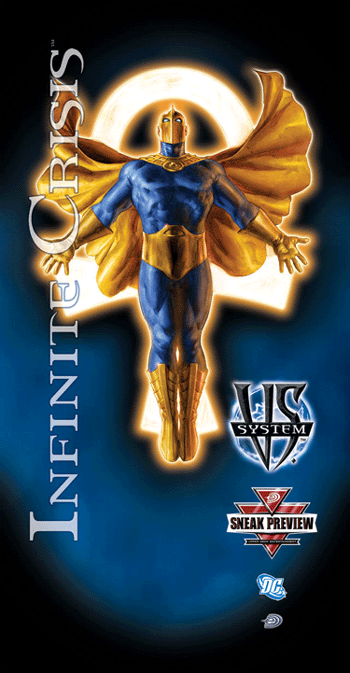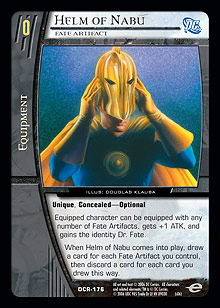
Welcome to the first in my series of design articles about Infinite Crisis. I’ll be taking the handoff from our fearless leader, Mike Hummel, who was lead designer on the excellent and exciting X-Men set. As lead designer of Infinite Crisis, I plan to use this series to give you a behind-the-scenes look at what goes into making a Vs. System set, highlighting the ins and outs of bringing Infinite Crisis to the game. My first couple of articles will focus on the broad themes of design from both a mechanical and a thematic standpoint. After that, I’ll go into many more specifics about the cards and teams in Infinite Crisis.
The Power . . . The Absolute Power!!!
My first article as a designer links back to my days as a Vs. System developer. I started working at R&D back during the design and development of Superman, Man of Steel. Back then, we subscribed to a different philosophy about how to design and develop cards. The theory was that by keeping cards within a tight power spectrum, players would be able to create strength through card synergies alone. By making sure that there were very few crazy effects, we would not risk getting cards banned.
I spent a lot of my time rebelling against this philosophy. I think card games are fun because you get to break the rules. Each card you play creates a new set of rules and, ideally, a new play experience. As a player, nothing gets me more excited than a powerhouse card around which I could build an entire deck. As a designer, I made sure that Infinite Crisis contained many such cards.

Are all of them good? Probably not. Some cards, like Secret Six Victorious, are designed to give you something interesting to think about and to present a challenge for deckbuilders. The Secret Six is filled with ways to help fulfill the condition necessary to win, but it will take some brilliant designers and players to make the deck win regularly.
Are any of them broken? Maybe. As I stated in a recent Inquest interview, my design philosophy is simply this: If we aren’t afraid of at least a few cards when the set walks out the door, then we haven’t done our job right. Keeping the game fresh and interesting involves breaking our own rules and doing things that have never been done before. We have an incredible development team led by the brilliant scientist and fashion trailblazer Dave Humpherys. I have a lot of faith in their ability to rein in my insanity and find the truly broken cards before they see print. But there is no way that any small team of people, no matter how talented, can compete with the combined minds of the Vs. community. There are less than ten of us and we have about three months to design and develop a set. There are thousands of you and you have years to figure out when we miss something. For Crisis in particular, the development team had a hard time of it because I continually pushed for open-ended cards that let players do things that we’ve always feared. I hope that none of the cards in Infinite Crisis need to be banned, but I would rather build a set where there is some risk of banning than have one where no card comes close.
Play More of Me!
Another change you’ll note from Infinite Crisis is that there are far fewer linear mechanics in this set. Linear design is basically when a mechanic gets better in proportion to the number of cards with that mechanic in your deck. This creates a . . . shall we say . . . affinity between specific cards and is often referred to around the office as a “play more of me” mechanic. Mechanics in Vs. that exemplify linear design are the recent Mutant mechanic from the X-Men and willpower from Green Lantern.
The good thing about linear design is that it gives players a clear handhold when they look at a set. What is the first thing to do when you see Mutant types? Well, you try to put all the Mutants of a specific type together and see what happens. Want to try out willpower? Put a whole bunch of willpower characters together and play cards that reference it. Some mechanics are not intrinsically linear, but specific cards we make create linearity. Reservist has turned out like this, as cards like Avengers Mansion and Wonder Man push you to play a deck filled almost entirely with reservist characters.
Linear mechanics provide a great entry point to Vs. because of the ease of deckbuilding. They also make for some powerful and cohesive decks because they are easy to develop. The downside of linear mechanics, however, is that they restrict what you can do as a player. Playing non-reservists in your reservist deck, for example, is a significant disadvantage and often not worth doing. This means that instead of having thousands of cards to choose from, players are generally restricted to looking at a handful of cards with which to fill the vast majority of their decks. Players looking for open-ended and creative deckbuilding will tend to lean away from linear mechanics.
 Infinite Crisis contains almost no linear mechanics. The most linear mechanic in Crisis is probably the identity mechanic in JSA, since characters of the same identity work so well together. Even that mechanic, however, is largely open-ended because you get to choose which identity you want to focus on. In addition, cards like A Moment of Crisis, Helm of Nabu, Mordru, and Taking up the Mantle let you “build your own” identity deck even from a disjointed set of characters.
Infinite Crisis contains almost no linear mechanics. The most linear mechanic in Crisis is probably the identity mechanic in JSA, since characters of the same identity work so well together. Even that mechanic, however, is largely open-ended because you get to choose which identity you want to focus on. In addition, cards like A Moment of Crisis, Helm of Nabu, Mordru, and Taking up the Mantle let you “build your own” identity deck even from a disjointed set of characters.
Open-ended design gives players a lot more options when creating their decks. This can be intimidating for new players, but for someone looking to explore the different possibilities for deckbuilding, it can be incredibly exciting. Many mechanics in Crisis were intentionally designed to be “play less of me” mechanics. Magic plot twists are very powerful, but playing too many of them is risky as your endurance payments add up. The Kings in Checkmate cause you to lose the game if one of them is KO’d, so putting two into play is very risky. These types of mechanics force players to look elsewhere for answers, expanding the possible play space greatly.
Another key to increasing the possibilities for deckbuilders is having good ways to team-up. Many of the most successful decks play only one team, and this set makes a conscious effort to make teaming-up easier. One of my favorite cards in Vs. is Midnight Sons because of all the possibilities it opens up. Crazy combination decks like New School (and its predecessor, Evil Medical School) give players a very different play experience and, in my opinion, greatly enrich the game. In homage to Midnight Sons, I made Coercion and Detective Chimp, Bobo T. Chimpanzee. These cards give their respective teams the ability to play loyalty characters from other teams without falling victim to their restrictions. In addition to team-specific Team-Ups, Infinite Crisis gives us Forbidden Loyalties, which may be the best generic Team-Up we have ever printed. Between that card and Millennium, players can now build team-up decks without “wasting” draws that do nothing but make their deck function properly.
The Dawn of a New Age
Infinite Crisis represents more than just another set in the Vs. System. It heralds the coming of the Silver Age. Pro Circuit San Francisco will be the first tournament to feature this new format, and since it does not contain the Origins sets, it fell upon Infinite Crisis to replace many of the staple cards in Golden Age. It was important to me that these cards were not strictly inferior or superior to their predecessors and that each had its own distinct flavor that fit in with this set. Transmutation replaces Have a Blast! but trades a discard payment for endurance, which works very well in a Shadowpact build. Blinding Rage doesn’t quite have the raw power of Savage Beatdown, but given its lower threshold cost, the Crisis plot twist can be superior in a deck with a lot of vengeance effects. Other cards, such as Defend Yourself!, can be even more of a Nasty Surprise than their Golden Age counterparts in a JSA exhaustion deck. These new cards give players access to some important basic game effects in Silver Age while presenting them with some interesting choices in Golden Age. We’ll have to wait until San Francisco to find out which of these new cards make their way into the new era of deckbuilding.
That’s all I’ve got for this week. Join me next week when I put a little flavor into our lives.
Send questions or comments to Justin_Gary@upperdeck.com.